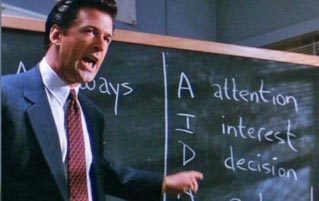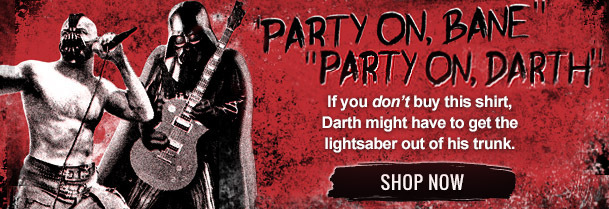5 Iconic Pop Culture Moments That Weren't in the Original

Some adaptations hew very closely to the original. After all, there's a reason you're adapting it in the first place, right? But some writers receive the original manuscript, decide that whatever crap they can pull out of their ass is far superior to the source material, and tear into it like a rabid toddler in a room full of Play-Doh. And thank God for them, because without those disrespectful bastards taking liberties with the sacred sources, we wouldn't have ...
The Iconic "Always Be Closing" Speech from Glengarry Glen Ross

Even if you've never seen Glengarry Glen Ross, there's a good chance you know Alec Baldwin's profanity-laden closer speech by heart, if for no other reason than we here at Cracked once used it to shame you into being a better person. But as amazing as that scene is, it's also quite out of sync with the rest of the film. Baldwin's character appears in this one scene, for this one thing, and then disappears forever. The rest of the movie concerns the mundane drama of shitty, shady salespeople whose best and most defining moment was getting yelled at by the magnificence that is Alec Baldwin.

This was back before it became a rite of passage for anyone living in lower Manhattan.
But Originally:
Find a member of the opposite sex with sad eyes and an elaborate scarf and score some art points by asking them to attend a live theater version of Glengarry. Sit there and get all pumped up, ready to mouth the "Coffee's for closers" speech under your breath, and ... prepare for disappointment. You won't find Baldwin's character anywhere in the play. Not only was he not present in the original work, but despite the movie scene's immense popularity, Baldwin's role has never been retconned into the play, since he ends up being pretty irrelevant to the storyline.

"Nice character? I don't give a shit. Good scene? Fuck you! Go home and play it on Netflix."
See, David Mamet is one of the fine and faithful who try to keep adaptations true to the source material (especially since it was his own material he was adapting). But the play version of Glengarry Glen Ross is incredibly short: Its two acts eat up maybe 75 minutes of the audience's time, not including intermission. Some creative padding was in order, and if you're going to fill up on bread sticks, why not make them delicious? They needed a few minutes of filler, so Baldwin was brought in to do what he does best: yell at everybody until they just want to die.
Milhouse from The Simpsons

Milhouse is a true nerd -- not one of those sexy new breeds of geeks who can "pass" if they need to. Milhouse cannot win, even though he deserves it. Milhouse is a wreck. Milhouse is an outcast. Milhouse is for us. That's why the truth is so painful: Milhouse is only in The Simpsons because of cynical product placement.

Which might be the Milhousiest origin possible.
But Originally:
In the beginning, Milhouse didn't even have a name. He was just a lukewarm body whose whole life sucked because his mom didn't stick a candy bar in his lunch bag. Starting in November 1989, before the actual show even began, Bart was already paying his family's bills by extolling the nutritional value of the Butterfinger food group.
That's Milhouse's first appearance. The character exists solely because they needed some other shitty kid to chuck in there next to Bart. His role could have been filled by Nelson, or Rod, or an anthropomorphic house plant.

Or an inanimate carbon rod.
Well, perhaps that's simplifying it a bit: The Milhouse sprite -- a blue-haired dork with giant rimmed glasses -- was originally part of a pilot for a Saturday morning cartoon that Simpsons creator Matt Groening wanted to get off the ground. But the pilot went nowhere, and poor Milhouse was doomed, as usual. Then Groening -- clearly not wishing to draw anything new that day -- reused Milhouse when animating the Butterfinger commercial. Once it was all down there on film, Groening liked the character's depressing lack of charisma enough to turn him into Bart's legitimate best friend when The Simpsons premiered a month later. The adult cartoon-viewing audience bonded with the poor hapless dork character for some reason, and he's stuck around ever since.
Agent Coulson of S.H.I.E.L.D.

Aside from Nick Fury himself, Agent Phil Coulson might be the most famous and popular member in S.H.I.E.L.D.'s entire 50-year history. Not bad for a middle-aged white dude with a receding hairline and a terminal case of Accountant Face.

"So I owe like 67 years in back taxes."
"I'm on it."
But Originally:
Yes, the concept of S.H.I.E.L.D. has been around for 50 years, debuting in 1965. But Coulson? He didn't show up until 2008, in the first Iron Man film. He was never in the comics. He didn't exactly get a grand entrance in the films either; he just sort of appeared midscene, awkwardly introduced himself to Gwyneth Paltrow, and then used his five or six minutes of screen time to apologize to the scenery. And yet somehow he proved popular enough to return in film after film, even securing his own TV show. Each time around, the writers fleshed him out more, mostly as a joke or a filler character, until they eventually wound up with a top-ranking agent who could really keep a team together, physically kick ass when he needed to, and even cheat death (to be fair, literally everybody in the Marvel universe cheats death on a nigh-hourly basis).

"Why else do you think Rhodey and Banner look so different now?"
Any Particular Reason for Frankenstein's Monster Coming to Life

You know the scene: A mad scientist finishes stitching together an unholy flesh-golem, which gets struck by lightning in the middle of the night. After a few tense moments, the creature begins to twitch and move. Then: "IT'S ALIVE!" followed by "IT'S CHOKING ME!" and "THIS WAS A POORLY THOUGHT OUT EVENING, AT BEST."

"WHY DIDN'T I USE DWARF PARTS?"
But Originally:
In Mary Shelley's novel, Frankenstein's monster comes to life thanks to ... absolutely nothing. Here's the original passage:
"I collected the instruments of life around me, that I might infuse a spark of being into the lifeless thing that lay at my feet ... by the glimmer of the half-extinguished light, I saw the dull yellow eye of the creature open; it breathed hard, and a convulsive motion agitated its limbs."
That's it. There's no lightning, no machines, no chemicals, no magic words, nothing. The monster comes to life just because it didn't have anything better to do that night. Maybe its nose itched. It's just the mystery of creation, you know? No need to go into detail.

Her original draft had a sentence that read, "Shit got real."
Actually, there's a good reason the story was told that way: It was supposed to be narrated by a deeply ashamed Dr. Frankenstein, telling his tale to a friend after the fact. He had long realized the error of his ways and did not want others to attempt his experiment. Purposefully omitting any and all steps of the process was his way of ensuring that nobody could even try.
But that doesn't play as well on screen, so the writers of the 1931 Frankenstein movie had to scrape together a whole new scene. Taking inspiration from the book's earlier description of lightning destroying a tree, they scripted the "lightning strikes machines attached to the monster and jolt it to life" scene that everybody knows and parodies to this day. And without them, what else would you shout every time you got an erection?

"IT'S CHOKING ME!" and "THIS WAS A POORLY THOUGHT OUT EVENING, AT BEST." -your penis
Most of What Makes Superman Work

When asked to name their favorite superpowered flying alien whose only weakness is a radioactive shard of his long-destroyed home planet, most people would probably pick Superman. When done well, Superman is a great combination: just the right amount of wish fulfillment (strength, invincibility, flight) balanced with enough weakness to make him interesting. Of course, without his Kryptonite, Superman would be boring, but everybody knows a hero has to have that one fatal flaw ...

No, that's Iron Man's.
But Originally:
Superman didn't have all of his iconic powers at the start. He couldn't even fly -- he just hopped around everywhere like a kangaroo on a sugar high. Also, he had no weaknesses, and thus he was generally as boring as mayonnaise on white bread. Superman didn't really become the Superman we know until 1940, when the radio serial The Adventures of Superman made its grand debut. Since the creators had only audio to work with, a few changes had to be made to the Superman mythos. For starters, they decided he could now fly, because it was far easier to convey flight through sound than "repeatedly jumping really hard." Seriously, you try it. Flight is a simple "WHOOSH," while jumping is a series of pained grunts. Is that Superman leaping a tall building or taking a coffee dump on the sidewalk midchase?
You can also thank the radio show for Kryptonite. The inspiration for the radioactive ore wasn't to give Superman a humanizing weakness and add some much-needed dramatic stakes to his stories; it was just to give Superman a damn day off every now and again. See, back in the '40s, they were dead serious about their entertainment: The radio show presented Superman as a real person who voiced himself, not a fictional character who shared a voice with some dude named Bud. Because, well, he's a good dude and all -- but Bud just takes a little of the mystique out of the affair, you know?

"Look! Down in the chair! It's a dude ... He's plain ... It's Bud!"
Unlike Superman, Bud was a weak-willed human being who needed to take a vacation every so often. So, the writers had to figure out a logical way to write off Superman for a few days at a time until Bud returned. Every time Bud needed a few days in Aruba, Supes would run into Kryptonite and go catatonic. When Bud returned, Superman continued, and the paychecks started rolling in again. It took the comics several years to realize that Superman was better with a weakness, but they eventually added Kryptonite to their repertoire in 1949, and it's been deus ex machina-ing Superman's omnipotent ass ever since.
Ian Ury is Pip Ury's twin brother, a general writer of stuff, and an occasional amateur animator. If you wanna comment, drop him an email. Ryan Menezes is a writer and layout editor here at Cracked. He broke down and made a Twitter page just for his Cracked fans.
For more interesting backstories, check out 14 Origin Stories of Real-World Villains and 23 Secret Backstories of Supporting Movie Characters.
Related Reading: Speaking of improvised pop culture moments, the Vulcan nerve pinch was originally a punch to the face. Oh hey and did you know the word Ewok was never said in the original trilogy? While we're at it; Mickey Mouse is the result of a last-minute name switch.
